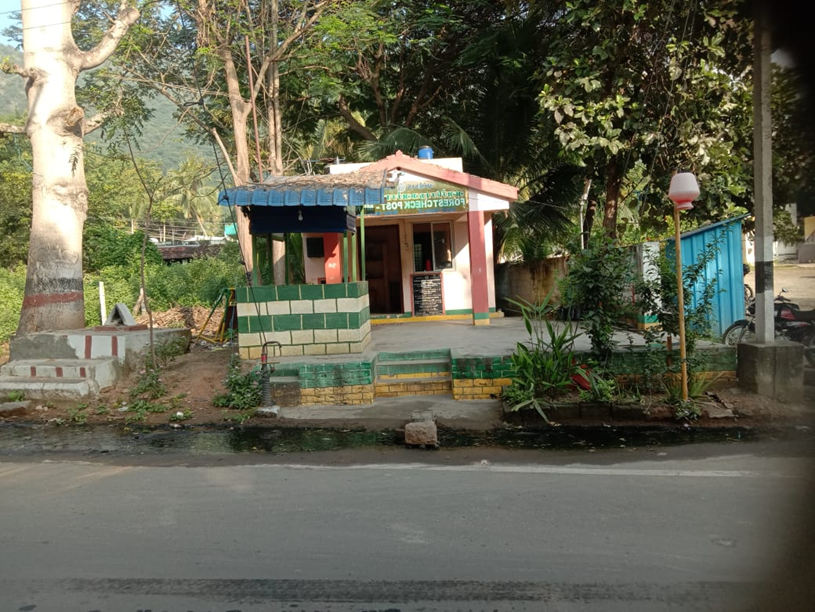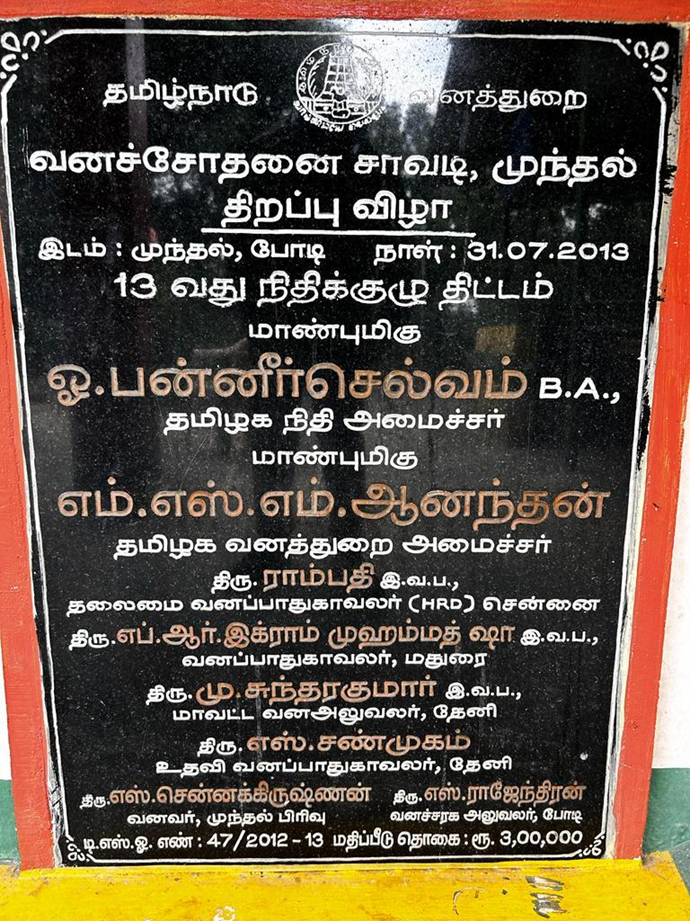EASTERN SLOPE OF THE VALLANADU
BLACKBUCK SANCTUARY VIEW FROM WATCHTOWER
Name, location, constitution and extent:
Nestled in the heart of Tamil Nadu
amidst the emerald embrace of the Srivaikundam taluk of Thoothukudi District,
lies a haven for one of India's most graceful creatures - the Blackbuck
Antelope. It is conveniently situated just 16 kilometers from the bustling city
of Tirunelveli and 35 kilometers from the pearl city of Thoothukudi. Woven from the historical tapestry of the
Vallanadu and Gangaikondan forests, this sanctuary serves as the southernmost
sanctuary in India where the blackbuck thrives. Historically, these elegant
creatures roamed free in the Vallanadu and Gangaikondan Forests. However, due
to habitat loss and hunting, their numbers dwindled significantly. Recognizing
the need to protect this endangered species, the government established the
Vallanadu Blackbuck Sanctuary within the larger Vallanadu Reserved Forests,
encompassing a dedicated 1,641 hectares as per G.O. Ms.No.1028 dated
28.09.1987.
The Vallanadu Blackbuck Sanctuary is
surrounded by the villages Manakarai, Vallanadu, Keela Vallanadu,
Muthangurichi, Udayanpatti, Alwarkarkulam, Kongarayankurichi,
Ellainayakkanpatti, Padmanabhamangalam, Arampannai and Thollappan pannai.
Water Management at Vallanadu sanctuary:
The Vallanadu Blackbuck Sanctuary, a
haven for the elegant blackbuck antelope, faces a significant challenge: a lack
of reliable water sources. Despite receiving an average annual rainfall of
750mm, the sanctuary suffers from an acute water shortage due to the absence of
perennial streams or rivers within its borders. This water scarcity has a
direct impact on the sanctuary's residents. To address this critical issue, the
forest department has taken proactive steps by drilling borewells, one powered
by solar energy and the other by electricity. Water holes created in Bangala
Saragam, karadi oothu, vagai maram thotti. The water bodies in VBS managed by
the forest department are often insufficient, leaving the animals dependent on
external sources. Fortunately, some perennial water sources exist outside the
sanctuary, such as old quarry pools, shallow open wells, and ponds. These vital
sources provide a lifeline for the animals, particularly during the dry
seasons.
Vallanadu Hills, classified as a
Southern thorn scrub 6A/DS1 forest type, unveils a fascinating tapestry of thorny
shrubs and diverse tree species. The primary tree species found in the hills
are Albizia lebbeck, Azadirachta indica, Bauhinia racemosa, Catunaregam
spinosa, Commiphora berryi, Commiphora berry, Dalbergia multiflora,
Dichrostachys cinerea, Gmelina arborea, Grewia orbiculata, Grewia villosa,
Lannea coromandelica, Prosopis juliflora, Wrightia tinctoria, ziziphus xylopyrus, ziziphus ziziphus and
various Acacia species.
Canthium parvifolium, Dodonaea viscosa, Lantana camara,
Pavetta indica, Pavonia odorata, Polygala javana and Ziziphus mauritiana are
some of the under shrubs found in the area.
Research studies have revealed a
remarkable tree density of 1335 trees per hectare in the Vallanadu hills.
Commiphora berryi dominated the STF with 334(25.02%) individuals, followed by
Acacia planifrons 261(19.55%), Dichrostachys cinerea 225(16.85%) and Acacia
mellifera 165(12.36%).
Acacia mellifera, despite its significant presence, presents a unique
challenge. Its dense, hooked thorns create a hostile environment for both
animals and plants. This thorny barrier hinders movement and makes it difficult
for other species to coexist within its domain, resulting in limited
regeneration beneath its canopy.
The
Vallanadu Blackbuck Sanctuary is not only a haven for the elegant blackbuck
antelope but also a thriving home for an astonishing variety of fascinating
creatures including monkeys, wild cats, macaques, jungle cats, jackal,
mongoose, vipers, black-napped hares, horned owls, sparrows, crested-hawk
eagles, jungle crows, peafowls, and herons. Among these remarkable creatures,
one stands out for its rarity - the Egyptian vulture. The sanctuary boasts over
166 varieties of this majestic bird and 60 varieties of butterflies, enriching
the unique ecological tapestry of the Vallanadu Blackbuck Sanctuary.
About Blackbucks:
The blackbuck, affectionately known as
pullvoi, Velli maan, Thiruku maan, and Murukku maan in Tamil, is an indigenous
species classified as threatened by the IUCN. While these elegant antelopes are
often spotted in open grasslands and cultivated fields across India, the
Vallanadu blackbuck uniquely prefers the vicinity of low hills covered in scrub
jungle. Unlike its brethren elsewhere, the Vallanadu blackbuck exhibits a
fascinating behavior - they retreat to their shelters at dawn and only
re-emerge at sunset, a behavior likely stemming from historical persecution.
The blackbuck, a medium-sized antelope,
boasts a graceful and slender build. Recognized as the swiftest of all
antelopes, this species exhibits a fascinating distinction – males differ from
females in color. The males' backs are a deep brown, extending to their sides
and the outer parts of their legs. In contrast, females (Doe) are a beautiful yellowish
fawn on their heads and backs. Both sexes share the same white markings on
their underparts, the insides of their legs, and around their eyes.
Interestingly, males become darker with age, and young males acquire the black
coat of adulthood at 3 years old.
Males are easily identified by their
impressive horns, which are ringed at the base and spiral upwards in stunning
twists, reaching up to five turns and measuring between 45 to 68cm. Their tails
are short, and their average height ranges from 74 to 84cm. On average, males
weigh between 20 and 57kg, while females are lighter, ranging from 20 to 33kg.
Their hooves are delicate and sharply pointed, aiding in agility and movement.
Blackbucks typically give birth to 1-2 young at a time, with a lifespan of
approximately 15 years. Males establish territories by depositing feces,
marking their domain and attracting females. Young blackbucks are remarkably
precocious, able to run soon after birth. As adults, males fiercely defend
their harems against rival bucks, ensuring the continuation of their lineage.
The blackbuck's presence in the Indian Zodiac
constellations serves as a testament to its historical significance.
Recreational Value:
The Vallanadu Blackbuck Sanctuary (VBS)
goes beyond being just a protected haven for wildlife. It serves as a
recreational paradise for nature enthusiasts, offering a plethora of
opportunities to immerse oneself in the wonders of the natural world. By promoting responsible ecotourism practices
and engaging in environmental education, VBS can continue to inspire awe and
foster a sense of responsibility towards protecting our planet for generations
to come.
Threat for the Blackbuck:
The Blackbuck habitat within the
Vallanadu Blackbuck Sanctuary (VBS) differs significantly from the surrounding
areas. While the landscape outside the sanctuary boasts an abundance of open
grass fallow, the interior is dominated by dense scrub vegetation on steep
terrain, considered unfavorable for blackbuck survival and movement. In an
effort to improve the habitat within the sanctuary, the Forest Department
undertook a commendable initiative and cleared an area of approximately 5
hectares in the eastern part of the sanctuary, removing the thorny trees and
shrubs that impeded blackbuck movement and access to resources.
VBS was established to protect a unique
antelope species, and faces a pressing challenge of habitat degradation.
Surrounding the sanctuary lies the private land, which once provided essential
habitat for the blackbuck population. Unfortunately, real estate development
has fragmented this land, creating isolated patches and restricting the
movement of the antelopes.
VBS also faces another unique challenge:
its status as a refuge for feral cattle. During the monsoon, these cattle find
ample food within the sanctuary's lush forests and during the dry season, they
venture out, mingling with domestic livestock and potentially returning to the
sanctuary at night.
Adding to the complexity, some calves
offered by villagers to the nearby Arulmigu Parvathy Amman Koil temple also
join the feral cattle population. These animals, including bulls and cows,
adapt to the environment, developing tough skin to survive under the thorny
bushes. Unfortunately, the presence of these feral cattle poses a significant
threat to the blackbuck population. They compete for the limited resources
within the sanctuary, including vital forage and water, jeopardizing the
blackbuck's survival. Furthermore, their potential to carry diseases poses a
risk not only to blackbuck but also to other herbivores like spotted deer. This
issue is particularly concerning in TAFCORN areas with higher feral cattle populations.
Beyond
the Eastern side boundary of the VBS are fragmented with housing plots




